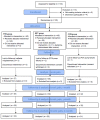Paravertebral Block Versus Preemptive Ketamine Effect on Pain Intensity after Posterolateral Thoracotomies: A Randomized Controlled Trial
- PMID: 32183267
- PMCID: PMC7141329
- DOI: 10.3390/jcm9030793
Paravertebral Block Versus Preemptive Ketamine Effect on Pain Intensity after Posterolateral Thoracotomies: A Randomized Controlled Trial
Abstract
Severe postoperative pain affects most patients after thoracotomy and is a risk factor for post-thoracotomy pain syndrome (PTPS). This randomized controlled trial compared preemptively administered ketamine versus continuous paravertebral block (PVB) versus control in patients undergoing posterolateral thoracotomy. The primary outcome was acute pain intensity on the visual analog scale (VAS) on the first postoperative day. Secondary outcomes included morphine consumption, patient satisfaction, and PTPS assessment with Neuropathic Pain Syndrome Inventory (NPSI). Acute pain intensity was significantly lower with PVB compared to other groups at four out of six time points. Patients in the PVB group used significantly less morphine via a patient-controlled analgesia pump than participants in other groups. Moreover, patients were more satisfied with postoperative pain management after PVB. PVB, but not ketamine, decreased PTPS intensity at 1, 3, and 6 months after posterolateral thoracotomy. Acute pain intensity at hour 8 and PTPS intensity at month 3 correlated positively with PTPS at month 6. Bodyweight was negatively associated with chronic pain at month 6. Thus, PVB but not preemptively administered ketamine decreases both acute and chronic pain intensity following posterolateral thoracotomies.
Keywords: ketamine; osterolateral thoracotomy; paravertebral block; thoracotomy; visual analog scale.
Conflict of interest statement
The authors declare no conflict of interest.
Figures
References
LinkOut - more resources
Full Text Sources


